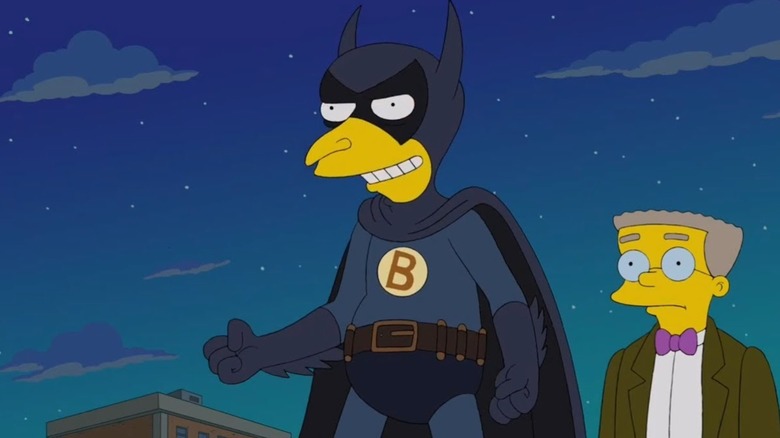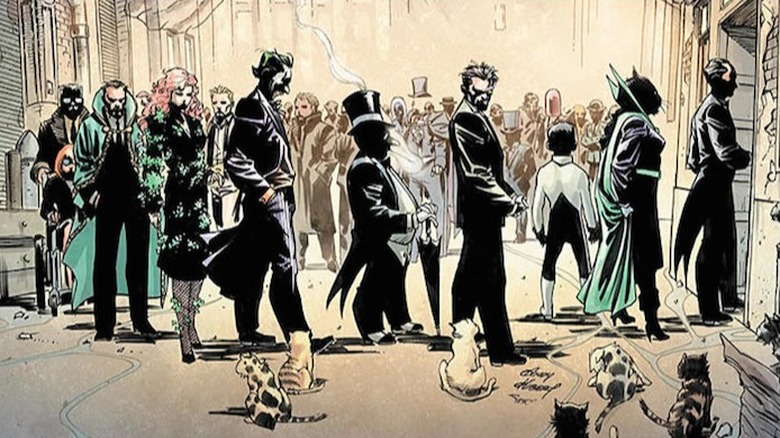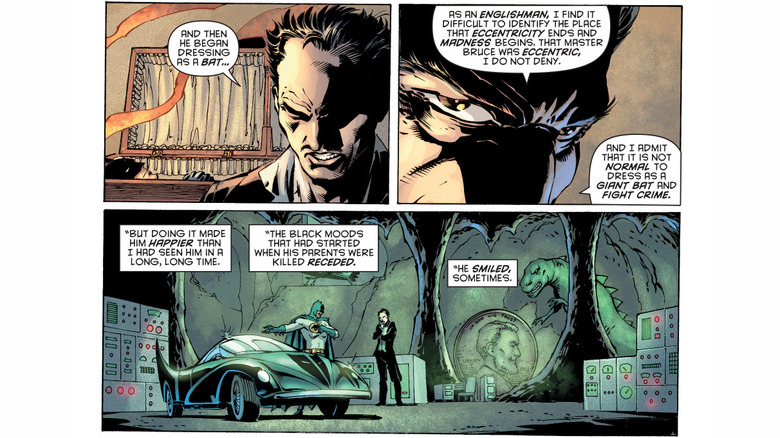This Simpsons Batman Parody Has An Undeniable Similarity With A Real DC Comic
"The Simpsons" has a long history of parodying Batman. Bart Simpson has the masked alter ego Bartman, who even starred in his own six-issue spin-off comic. Season 4 classic "Mr. Plow," one of the best "Simpsons" episodes, features Adam West as himself; he laments the lack of Robin (and the Batusi dance) in the then-contemporary Tim Burton "Batman" movies. You can draw a straight line from West parodying himself like this to his eventual recurring role on "Family Guy."
In "The Simpsons" season 24's "Dark Knight Court," Mr. Burns and Smithers stumble into the Android's Dungeon, where Burns rediscovers his childhood love of comic books. Reading the copyright-friendly "Detection Comics," Monty has his "he just like me FR!" moment with Batman ("reclusive millionaire, stately mansion, damaged psyche"). So, he decides to become a caped crusader of the night as Fruit Bat Man, whose exploits are scored to music much like Hans Zimmer's operatic "Dark Knight" trilogy score.
Of course, there are no actual supervillains in Springfield, nor does Burns have the athletic ability or detective skills to fight them if there were. So, Smithers just pays people to pretend to be criminals and/or victims, allowing the unsuspecting Burns to act out his superhero fantasies.
The story is pretty out there; part of me thinks it would be more at home in a "Treehouse of Horror" episode, a la "Bartman Begins" in season 18's "Revenge Is a Dish Best Served Three Times." However, it at least ties into the episode's A-plot by the end. Bart is on trial for seemingly disrupting the Springfield Easter celebration, but Fruit Bat Man catches the real culprit: Groundskeeper Willie. It's unclear if episode writers Billy Kimball and Ian Maxtone-Graham knew this, but "Dark Knight Court" has a similar premise to a real Batman comic.
Whatever Happened to the Caped Crusader?`
During their run on "Batman," Grant Morrison decided to temporarily kill off Bruce Wayne for a new status quo. Dick Grayson, the original Robin and then Nightwing, would become Batman, and Bruce's son Damian Wayne would be Robin. The final issues of both "Batman" and "Detective Comics" before this relaunch were grouped together into one story: "Whatever Happened to the Caped Crusader" ("Batman" #686 is Part 1, "Detective Comics" #853 is Part 2).
This story was not written by Morrison, but by "Sandman" creator Neil Gaiman, with art by Andy Kubert. It centers around Batman's funeral, where each of his closest peers gives a (conflicting) account of their relationship and how he died. It's a premise that evokes the four-part 1977 story, "Where Were You The Night Batman Died" ("Batman" issues #291-294, by David Vern Reed and Jon Calnan), where Catwoman, the Riddler, the Joker, and Lex Luthor all take credit for killing Batman.
"Batman" #686 features two eulogies: first Catwoman's and then that of Batman's loyal butler and surrogate father, Alfred Pennyworth. The second one is where the overlap with "Dark Knight Court" lies.
The Gentleman's Gentleman's Tale
In Alfred's eulogy, he recounts his days acting in a theater company before he came to serve the Wayne family. As Alfred raises the orphaned Bruce, he notices the only thing that makes the boy smile is his delusional quest to fight crime. However, when Bruce tries to protect Gotham City as Batman, he only gets himself hurt. So, Alfred calls upon his old acting company mates and has them dress up as eccentric supervillains for Batman to thwart. Alfred himself plays the part of the Joker; a six-panel page shows him applying Joker makeup before a mirror, piece by piece, until the Crown Prince of Crime is born.
Of course, none of these actors are actual villains and no one is really being hurt or imprisoned — until one day, Bruce (a genuinely skilled detective despite all this) learns the truth. Despite the lies, he decides he can't give up — Batman wouldn't, after all. When Eddie Nash (now insane and buying into his Riddler persona) takes hostages, Batman goes to talk him down. Since it's no longer mere play, Eddie kills Bruce with a shot to the head and gets taken to a "real mad house," not the pretend Arkham Asylum.
"Whatever Happened to the Caped Crusader" isn't meant to be taken as canon; it's a metatext that acknowledges the different interpretations of Batman as an unwieldy whole. So, next time you read a Batman comic with the Joker, don't think it's secretly Alfred behind the makeup. To quote Alan Moore and his 1986 Superman farewell story "Whatever Happened to the Man of Tomorrow" — "This is an Imaginary Story... aren't they all?"


